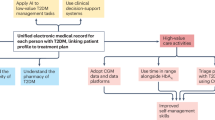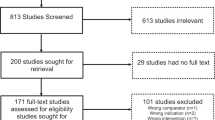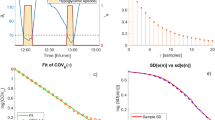Abstract
Background
Starting March 2020 the Italian Government imposed a lockdown to limit the spread of SARS-CoV-2. During lockdown outpatient visits were limited and telemedicine (TM) was encouraged.
Methods
We retrospectively analyzed data from continuous or flash glucose monitoring systems shared through different cloud systems during the lockdown by subjects with type 1 diabetes and compared data obtained 4 weeks before and 4 weeks after structured telephonic visit. Variables considered were mean glucose, time spent in target (70–180 mg/dl), hypoglycemia (<70 mg/dl) and hyperglycemia (>180 mg/dl), coefficient of variation, and length of sensor use.
Results
During the 4 weeks following the telephonic visit there was an improvement of glycemic control, with a significant reduction of mean glucose values (161.1 before vs 156.3 mg/dl after, p = 0.001), an increase of the time spent in target (63.6 vs 66.3, p = 0.0009) and a reduction of time spent in hyperglycemia (33.4 vs 30.5, p = 0.002). No changes were observed regarding glucose variability, time spent in hypoglycemia, and length of sensor use. Similar results were observed in subjects treated with multiple daily injections or continuous subcutaneous insulin infusion.
Conclusions
A structured telephonic visit appears to be an effective way to replace or integrate routine visits in particular conditions.
Similar content being viewed by others
Introduction
In December 2019, an epidemic of pneumonia related to a new strain of Coronavirus developed in the Chinese province of Wuhan. The infection is caused by the severe acute respiratory syndrome coronavirus 2 (SARS-CoV-2), caries a high mortality risk and is now known as coronavirus disease 2019 (COVID- 19)1,2.
Starting February 2020, COVID19 hit abruptly North Italy that quickly became the area in the world most severely affected by the infection. To limit the spread of the epidemic at the end of February, the Italian government imposed a series of restrictions which led to the complete closure of any non-urgent work and commercial activity3 arriving, during March and April 2020 to a complete lockdown. During the lockdown all citizens were invited to stay home and hospitals canceled all non-urgent activities, including visits of people with diabetes4,5.
To control glucose levels, persons with type 1 diabetes (T1D) use glucometers or devices for continuous glucose monitoring, that both allow the sharing of data with their clinicians through dedicated cloud platforms, indeed clinicians have taken advantage of this opportunity to replace or supplement regular visits particularly in subjects using continuous glucose monitoring (CGM) or Flash glucose Monitoring (FGM) systems6,7,8,9.
CGM and FGM data can be visualized through receivers or Smartphone apps and these data can be uploaded into a cloud-system if the receiver is connected to a website or can be transmitted to a smartphone app in real time. Different CGM and FGM systems have developed specific web platforms that allow clinicians and patients to interact both during visits and by remote (telemedicine).
It has been demonstrated that telemedicine improves some psychosocial outcomes in young adults with diabetes10, but there are few data regarding its efficacy in glycemic control. Very recently some evidence has been published about the role of telemedicine in T1D in particular populations or in special situations, for example in new diagnosed T1D11,12,13.
There are few data regarding the efficacy of telemedicine in persons with T1D. Aim of the study was to evaluate the role of telemedicine in patients with TID using CGM or FGM under the extreme circumstances brought about by COVID-19.
Methods
This is a monocentric observational retrospective study conducted at the Unit of Metabolic Disease of the University of Padova, between 9 March and 11 May 2020, when regular visits were replaced by a structured phone colloquium (Telemedicine Visit, TM).
We enrolled all consecutive patients with T1D, using a CGM or FGM and who performed a TM. Enrolled patients have been using FGM or CGM for more than 6 months and actively shared active data with our clinic through dedicated platforms. The platforms used were Libreview (Abbott Diabetes Care) for FGM data (FreeStyle Libre, Abbott Diabetes Care) www.libreview.com, Dexcom Clarity14 (Dexcom, San Diego, CA) for Dexcom sensors (DexcomG5 and Dexcom G6), and Eversense DMS (Eversense, Senseonics) for implantable sensor. Subjects treated with Multiple daily injection (MDI) and continuous subcutaneous insulin infusion (CSII) were enrolled, with no restriction about metabolic control. Pregnant subjects were excluded because glycemic control could be influenced by different glycemic target required during pregnancy. Similarly, subjects switched from MDI to CSII in the previous 6 months were excluded to avoid changes in glucose control related to new therapy.
During TM the clinician evaluated glucose data accessible through platforms, and registered all blood and instrumental exams sent by email. Data were discussed with the subjects during TM and, at the end of the connection, a report was sent by email to the patient with changes in insulin dosage on the basis of the glucose trend.
We evaluated glucose control according to existing guidelines15. In particular, we evaluated mean glucose values, glucose management indicator (GMI, a new formula to estimate glycosylated Hemoglobin from mean glucose values)16, time spent in target range (% of time with glucose values between 70 and 180 mg/dl), in hypoglycemia (% of time with values below 70 mg/dl) or in hyperglycemia (% of time with glucose values above 180 mg/dl), and the coefficient of variation (CV) that is now considered the best indicator of glucose variability. Furthermore, we evaluated information on sensor use, defined as % of sensor use during the period. Regarding FGM use we collected data about number of scans performed during each period. All these data were automatically generated by the platform software of each device. Baseline metabolic control, expressed as mean of HbA1c values in the previous year, and anthropometric parameters were obtained from electronic records.
To evaluate TM efficacy, we considered glucose control during the 4 weeks before and the 4 weeks after TM. A separated analysis regarding differences between subjects treated with MDI and CSII was performed to investigate if glycemic control changes could be related with therapy.
The study was performed in accordance with the Helsinki Declaration of 1964, and its later amendments, and was in agreement with national regulations. The study was conceived as a retrospective data collection and notification of the study has been done to the local Ethical Committee.
Statistical analysis
Continuous variables are presented as the mean ± standard deviation (SD) if normally distributed or as the median and interquartile range (IQR) if non-normally distributed. Categorical variables were presented as percentages. Comparison of variables recorded before and after TM visit was performed using the two-tail paired Student’s t test. Statistical significance was accepted at p < 0.05.
Results
We enrolled 71 T1D (Table 1), mean age 41.9 years, with an acceptable metabolic control during the previous year (mean HbA1c 7.5%). Most of the subjects were in multi daily injections (MDI) therapy (54.9%). Patients on MDI were younger and with shorter diabetes duration than MDI subjects.
Fifty two subjects used FGM and 19 used CGM, the majority of devices being from Dexcom (84.2% of CGM users).
Glucose control improved after TM. In fact during the 4 weeks after TM (Table 2) there was a significant reduction of mean glucose values (p = 0.001), an increase of the time spent in target (from 63.6% to 66.4%, p < 0.001) and a reduction of the time spent in hyperglycemia (from 33.4% to 30.5%, p = 0.001). No changes were observed in time spent in hypoglycemia and in CV. The improvement in glycemic control does not appear to be due to differences in the time of sensor use (Table 2), nor to the number of scans for subjects using FGM (11.4 vs 10.3 scan/day, p = 0.3).
Considering MDI and CSII subjects separately, as shown in Table 3, we found similar effects of TM on glycemic control in both groups.
Finally, we divided subjects in 2 groups, on the basis of TM visit date, to exclude that the impact on glycemic control was linked to the lockdown itself, as recently demonstrated17. We evaluated separately subjects that lived during lockdown both periods, before and after TM. This subgroup, composed by 30 subjects, had a similar improvement of glycemic control with a reduction of mean glucose from 160.2 to 154.4 (p = 0.01), an increase of time spent in target from 64.1 to 67.1 (p = 0.009), and a reduction of time spent in hyperglycemia (32.6 vs 29.6, p = 0.01).
Discussion
This study analyzed feasibility and efficacy of remote glycemic control in T1D subjects, through a telephone visit. The Covid 19 emergency made this type of remote control necessary but once the emergency was over, this type of approach could be offered as an alternative or integration to the usual visit.
Obviously, the remote control is not intended to replace the visit, especially as regards education in the management of diabetes and use of technology.
We found that a structured telemedicine visit, which includes the discussion of glycemic data and the provision of written suggestions, had a positive impact in the glycemic control of T1D. We recently demonstrated that during lockdown glycemic control improved in patients who discontinued work17, probably because they were able to pay more attention to diabetes control. However, the improvement in glycemic control that we found after the telemedicine visit does not appear to be attributable to the lockdown since the telemedicine visit improved glucose control also in the subgroup that entirely lived in lockdown during both periods, before and after TM. Efficacy of TM is not related to type of insulin therapy since the improvement was similar in MDI and CSII subjects.
We have no data regarding T1D satisfaction, but it is reasonable to consider that this solution can be appreciated by patients. In fact, TM leads to a journey reduction for patients, with a reduction in the loss of working days.
This study has limitations. First, just patients using continuous blood glucose monitoring devices were evaluated.
Furthermore, we excluded people who did not use the data sharing platforms with the possibility of selecting persons most motivated and more bent to use new technologies.
Finally, the present conclusions about TM efficacy were reached through a short study regarding a small number of subjects. A short observation obviously leads to a lack of information about long-term metabolic control, like HbA1c.
This study shows that telemedicine can be a useful and effective support in the management of subjects with T1D. The strategy changes imposed by the COVID 19 emergency could open new avenues in the treatment of sick patients18.
References
Zhu, N. et al. A novel coronavirus from patients with pneumonia in China, 2019. N. Engl. J. Med 382, 727–733 (2020).
He, F., Deng, Y. & Li, W. Coronavirus disease 2019: What we know?. J Med Virol 92, 719–725, https://doi.org/10.1002/jmv.25766 (2019).
Lazzerini, M. & Putoto, G. COVID-19 in Italy: momentous decisions and many uncertainties. Lancet Glob Health 8, e641–e642, https://doi.org/10.1016/S2214-109X(20)30110-8 (2020).
Gupta, R., Ghosh, A., Singh, A. K. & Misra, A. Clinical considerations for patients with diabetes in times of COVID-19 epidemic. Diabetes Metab. Syndr. 14, 211–212 (2020).
Iacobucci, G. Covid-19: diabetes clinicians set up social media account to help alleviate patients’ fears. BMJ 368, m1262 (2020).
Continuous Glucose Monitoring Sensors: Past, Present and Future Algorithmic Challenges. Sensors 16, 2093 (2016).
Bruttomesso, D. et al. The use of real time continuous glucose monitoring or flash glucose monitoring in the management of diabetes: a consensus view of Italian diabetes experts using the Delphi method. Nutr. Metab. Cardiovasc. Dis. 29, 421–431 (2019).
Cappon, G., Vettoretti, M., Sparacino, G. & Facchinetti, A. Continuous glucose monitoring sensors for diabetes management: a review of technologies and applications. Diabetes Metab. J. 43, 383–397 (2019).
Edelman, S. V., Argento, N. B., Pettus, J. & Hirsch, I. B. Clinical implications of real-time and intermittently scanned continuous glucose monitoring. Diabetes Care 41, 2265–2274 (2018).
Bakhach, M. et al. Home telemedicine (CoYoT1 Clinic): a novel approach to improve psychosocial outcomes in young adults with diabetes. Diabetes Educ. 45, 420–430 (2019).
Garg, S. K., Rodbard, D., Hirsch, I. B. & Forlenza, G. P. Managing new-onset type 1 diabetes during the COVID-19 pandemic: challenges and opportunities. Diabetes Technol. Ther. 22, 431–439 (2020).
Jones, M. S. et al. Inpatient transition to virtual care during COVID-19 pandemic. Diabetes Technol. Ther. 22, 444–448 (2020).
Peters, A. L. & Garg, S. K. The silver lining to COVID-19: avoiding diabetic ketoacidosis admissions with telehealth. Diabetes Technol. Ther. 22, 449–453 (2020).
Dexcom clarity: dexcom CLARITY diabetes management software. www.dexcom/clarity (2020).
Battelino, T. et al. Clinical targets for continuous glucose monitoring data interpretation: recommendations from the international consensus on time in range. Diabetes Care 42, 1593–1603 (2019).
Bergenstal, R. M. et al. Glucose Management Indicator (GMI): a new term for estimating A1C from continuous glucose monitoring. Diabetes Care 41, 2275–2280 (2018).
Bonora, B. M., Boscari, F., Avogaro, A., Bruttomesso, D. & Fadini, G. P. Glycaemic control among people with type 1 diabetes during lockdown for the SARS-CoV-2 outbreak in Italy. Diabetes Ther. 11, 1369–1379 (2020).
Klonoff D. C. Telemedicine for diabetes after the COVID-19 pandemic: we can’t put the toothpaste back in the tube or turn back the clock. J. Diabetes Sci. and Technol. https://doi.org/10.1177/1932296820932958 (2020).
Author information
Authors and Affiliations
Contributions
F.B. and D.B. designed the study, had full data access, and drafted the manuscript. S.F. and A.U. collected data and critically reviewed the manuscript. A.A. critically reviewed the manuscript.
Corresponding author
Ethics declarations
Conflict of interest
The authors declare that they have no conflict of interest.
Additional information
Publisher’s note Springer Nature remains neutral with regard to jurisdictional claims in published maps and institutional affiliations.
Rights and permissions
Open Access This article is licensed under a Creative Commons Attribution 4.0 International License, which permits use, sharing, adaptation, distribution and reproduction in any medium or format, as long as you give appropriate credit to the original author(s) and the source, provide a link to the Creative Commons license, and indicate if changes were made. The images or other third party material in this article are included in the article’s Creative Commons license, unless indicated otherwise in a credit line to the material. If material is not included in the article’s Creative Commons license and your intended use is not permitted by statutory regulation or exceeds the permitted use, you will need to obtain permission directly from the copyright holder. To view a copy of this license, visit http://creativecommons.org/licenses/by/4.0/.
About this article
Cite this article
Boscari, F., Ferretto, S., Uliana, A. et al. Efficacy of telemedicine for persons with type 1 diabetes during Covid19 lockdown. Nutr. Diabetes 11, 1 (2021). https://doi.org/10.1038/s41387-020-00147-8
Received:
Revised:
Accepted:
Published:
DOI: https://doi.org/10.1038/s41387-020-00147-8
This article is cited by
-
Telemedicine for the Clinical Management of Diabetes; Implications and Considerations After COVID-19 Experience
High Blood Pressure & Cardiovascular Prevention (2022)
-
Psychosocial and behavioral correlates of weight loss 12 to 15 years after bariatric surgery
Journal of Behavioral Medicine (2022)
-
Glucose control in diabetes during home confinement for the first pandemic wave of COVID-19: a meta-analysis of observational studies
Acta Diabetologica (2021)
-
Telemonitoring, Telemedicine and Time in Range During the Pandemic: Paradigm Change for Diabetes Risk Management in the Post-COVID Future
Diabetes Therapy (2021)



